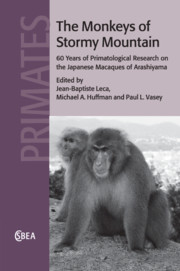19 results
Part II - Sexual behaviour
-
- Book:
- The Monkeys of Stormy Mountain
- Published online:
- 05 March 2012
- Print publication:
- 19 January 2012, pp 69-220
-
- Chapter
- Export citation
The Monkeys of Stormy Mountain - Title page
-
-
- Book:
- The Monkeys of Stormy Mountain
- Published online:
- 05 March 2012
- Print publication:
- 19 January 2012, pp iii-iii
-
- Chapter
- Export citation
Series page
-
- Book:
- The Monkeys of Stormy Mountain
- Published online:
- 05 March 2012
- Print publication:
- 19 January 2012, pp ii-ii
-
- Chapter
- Export citation
13 - Thirty years of stone handling tradition in Arashiyama-Kyoto macaques: implications for cumulative culture and tool use in non-human primates
- from Part III - Cultural behaviour, social interactions and ecology
-
-
- Book:
- The Monkeys of Stormy Mountain
- Published online:
- 05 March 2012
- Print publication:
- 19 January 2012, pp 223-257
-
- Chapter
- Export citation
Part III - Cultural behaviour, social interactions and ecology
-
- Book:
- The Monkeys of Stormy Mountain
- Published online:
- 05 March 2012
- Print publication:
- 19 January 2012, pp 221-432
-
- Chapter
- Export citation
Copyright page
-
- Book:
- The Monkeys of Stormy Mountain
- Published online:
- 05 March 2012
- Print publication:
- 19 January 2012, pp iv-iv
-
- Chapter
- Export citation
Appendix: Bibliography of publications on the Arashiyama macaques
-
- Book:
- The Monkeys of Stormy Mountain
- Published online:
- 05 March 2012
- Print publication:
- 19 January 2012, pp 470-494
-
- Chapter
- Export citation
Preface
-
- Book:
- The Monkeys of Stormy Mountain
- Published online:
- 05 March 2012
- Print publication:
- 19 January 2012, pp xv-xviii
-
- Chapter
- Export citation
Contributors
-
-
- Book:
- The Monkeys of Stormy Mountain
- Published online:
- 05 March 2012
- Print publication:
- 19 January 2012, pp x-xi
-
- Chapter
- Export citation

The Monkeys of Stormy Mountain
- 60 Years of Primatological Research on the Japanese Macaques of Arashiyama
-
- Published online:
- 05 March 2012
- Print publication:
- 19 January 2012
Dedication
-
- Book:
- The Monkeys of Stormy Mountain
- Published online:
- 05 March 2012
- Print publication:
- 19 January 2012, pp v-vi
-
- Chapter
- Export citation
1 - A brief historical timeline of research on the Arashiyama macaques
- from Part I - Historical perspectives
-
-
- Book:
- The Monkeys of Stormy Mountain
- Published online:
- 05 March 2012
- Print publication:
- 19 January 2012, pp 13-27
-
- Chapter
- Export citation
Part IV - Management and education
-
- Book:
- The Monkeys of Stormy Mountain
- Published online:
- 05 March 2012
- Print publication:
- 19 January 2012, pp 433-469
-
- Chapter
- Export citation
Part I - Historical perspectives
-
- Book:
- The Monkeys of Stormy Mountain
- Published online:
- 05 March 2012
- Print publication:
- 19 January 2012, pp 11-68
-
- Chapter
- Export citation
Index
-
- Book:
- The Monkeys of Stormy Mountain
- Published online:
- 05 March 2012
- Print publication:
- 19 January 2012, pp 495-499
-
- Chapter
- Export citation
Contents
-
- Book:
- The Monkeys of Stormy Mountain
- Published online:
- 05 March 2012
- Print publication:
- 19 January 2012, pp vii-ix
-
- Chapter
- Export citation
Introduction
-
-
- Book:
- The Monkeys of Stormy Mountain
- Published online:
- 05 March 2012
- Print publication:
- 19 January 2012, pp 1-10
-
- Chapter
- Export citation
Cambridge Studies in Biological and Evolutionary Anthropology 61 - Half title page
-
- Book:
- The Monkeys of Stormy Mountain
- Published online:
- 05 March 2012
- Print publication:
- 19 January 2012, pp i-i
-
- Chapter
- Export citation
15 Box essay - Dental flossing behaviour as a grooming-related innovation by a Japanese macaque
- from Part III - Cultural behaviour, social interactions and ecology
-
-
- Book:
- The Monkeys of Stormy Mountain
- Published online:
- 05 March 2012
- Print publication:
- 19 January 2012, pp 321-330
-
- Chapter
- Export citation



